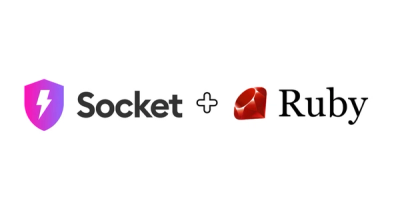
Product
Rubygems Ecosystem Support Now Generally Available
Socket's Rubygems ecosystem support is moving from beta to GA, featuring enhanced security scanning to detect supply chain threats beyond traditional CVEs in your Ruby dependencies.
Lightweight stream oriented messaging library.
SocketMQ supports req/rep and pub/sub messaging patterns. Messaging pattern is high level concept of how messages should be handled on sending and receiving. It's client/server & transport agnostic which means you can use all 4 types of messaging pattern no matter you are connected to a server or being connected from a client with any of the transports supported.
Each request will be sent to one connected client/server and wait for response (round-robin scheduler).
// example/rep.js
var socketmq = require('../')
var smq = socketmq.bind('tcp://127.0.0.1:6363')
smq.on('bind', function() {
console.log('rep bound')
})
var event = 'hello' // or you can call it topic or channel.
smq.on('connect', function(stream) {
console.log('new connection')
smq.req(event, 'request from server', function (msg) {
console.log(msg)
})
})
smq.rep(event, function(msg, reply) {
console.log('requested msg:' + msg)
reply('Hi ' + msg + ', world!')
})
// example/req.js
var socketmq = require('socketmq')
var smq = socketmq.connect('tcp://127.0.0.1:6363')
smq.on('connect', function(stream) {
console.log('req connected to server')
})
setInterval(function() {
smq.req('hello', 'socketmq.req', function(msg) {
console.log('replied msg:' + msg)
})
}, 1000)
smq.rep('hello', function (msg, reply) {
console.log('request from server', msg)
reply('response from client')
})
A pub message will be distributed to all client/server connected and no response will be sent back. It's a fire and forget messaging pattern. Pub messages could be received by subscribing to the publishing topic.
// example/pub.js
var socketmq = require('socketmq')
var smq = socketmq.connect('tcp://0.0.0.0:6363')
smq.on('connect', function() {
console.log('pub connected');
setInterval(function() {
smq.pub('pub.test', 'hello')
}, 1000)
})
// example/sub.js
var socketmq = require('socketmq')
var smq = socketmq.bind('tcp://127.0.0.1:6363')
smq.on('bind', function() {
console.log('sub bound')
})
smq.sub('pub.test', function(data) {
console.log('got pub message: ' + data)
})
SocketMQ can tag the streams and send messages to streams with specific tags.
var socketmq = require('socketmq')
var tcpUri = 'tcp://127.0.0.1:6363'
var smq = socketmq.connect(tcpUri, function(stream) {
// Tag the stream.
smq.tag(stream, 'tcp')
})
var tlsUri = 'tls://127.0.0.1:46363'
smq.connect(tlsUri, function(stream) {
smq.tag(stream, 'tls')
})
// Then send messages using `reqTag` of `pubTag`
// `req` message only to server with `tcp` tag
smq.reqTag('tcp', 'hello', 'message', function(){
// ...
})
// `pub` message only to server with `tls` tag
smq.pubTag('tls', 'hello', 'message')
FAQs
Lightweight messaging library for node & browser.
The npm package socketmq receives a total of 8 weekly downloads. As such, socketmq popularity was classified as not popular.
We found that socketmq demonstrated a not healthy version release cadence and project activity because the last version was released a year ago. It has 2 open source maintainers collaborating on the project.
Did you know?

Socket for GitHub automatically highlights issues in each pull request and monitors the health of all your open source dependencies. Discover the contents of your packages and block harmful activity before you install or update your dependencies.

Product
Socket's Rubygems ecosystem support is moving from beta to GA, featuring enhanced security scanning to detect supply chain threats beyond traditional CVEs in your Ruby dependencies.

Research
The Socket Research Team investigates a malicious npm package that appears to be an Advcash integration but triggers a reverse shell during payment success, targeting servers handling transactions.

Security Fundamentals
The Socket Threat Research Team uncovers how threat actors weaponize shell techniques across npm, PyPI, and Go ecosystems to maintain persistence and exfiltrate data.